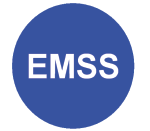Opt-Sim approach for the gate allocation problem in covid-19 times
- a,b Amsterdam School of International Business – Amsterdam University of Applied Sciences, Fraijlemaborg 133, Amsterdam, 1102CV, The Netherlands
- c Aviation Academy – Amsterdam University of Applied Sciences, Weesperzijde 190, Amsterdam, 1097 DZ, The Netherlands
Cite as
Scala P., Bagamanova M., Mujica Mota M. (2021). Opt-Sim approach for the gate allocation problem in covid-19 times. Proceedings of the 33rd European Modeling & Simulation Symposium (EMSS 2021), pp. 173-182. DOI: https://doi.org/10.46354/i3m.2021.emss.024
Abstract
This study tackles the gate allocation problem (GAP) at the airport terminal, considering the current covid-19 pandemic restrictions. The GAP has been extensively studied by the research community in the last decades, as it represents a critical factor that determines an airport's capacity. Currently, the airport passenger terminal operations have been redesigned to be aligned and respect the covid-19 regulation worldwide. This provides operators with new challenges on how to handle the passengers inside the terminal. The purpose of this study is to come up with an efficient gate allocator that considers potential issues derived by the current pandemic, i.e., avoid overcrowded areas. A sim-opt approach has been developed where an evolutionary algorithm (EA) is used in combination with a dynamic passenger flow simulation model to find a feasible solution. The EA aims to find a (sub)optimal solution for the GAP, while the simulation model evaluates its efficiency and feasibility in a real-life scenario. To evaluate the potential of the Opt-Sim approach, it has been applied to a real airport case study
References
- Abdelghany, A., Abdelghany, K., Azadian, F., 2017. Airline flight schedule planning under competition. Computers and Operations Research 87, 20–39. https://doi.org/10.1016/j.cor.2017.05.013
- ARC, 2021. CAST. https://arc.de/cast-simulation-software/. Accessed on: March 2021.
- Bagamanova, M., Mujica Mota, M., 2020a. A multi-objective optimization with a delay-aware component for airport stand allocation. Journal of Air Transport Management 83, 101757. https://doi.org/10.1016/j.jairtraman.2019.101757
- Bagamanova, M., Mujica Mota, M., 2020b. Reducing airport environmental footprint using a disruption-aware stand assignment approach. Transportation Research Part D: Transport and Environment 89, 102634. https://doi.org/10.1016/j.trd.2020.102634
- Das, G.S., Gzara, F., Stutzle, T, 2020. A review on airport gate assignment problems: single versus multi objective approaches. Omega. Vol. 92, pp. 102/146. Doi: https://doi.org/10.1016/j.omega.2019.102146
- EASA. 2020. COVID-19 Aviation Health Safety Protocol : Operational Guidelines for the management of air passengers and aviation personnel in relation to the COVID-19 pandemic.
- EUROCONTROL, 2021. EUROCONTROL Comprehensive Assessment of COVID-19's Impact on European Air Traffic. https://www.eurocontrol.int/publication/eurocontrol-comprehensive-assessment-covid-19s-impact-european-air-traffic. Accessed on: April 2021.
- Federal Aviation Administration (FAA), 2020. Covid-19: Updated interim occupational health and safety guidance for air carriers and crews.
- Ghazouani, H., Hammami, M., Korbaa, O., 2015. Solving airport gate assignment problem using Genetic Algorithms approach, in: 2015 4th IEEE International Conference on Advanced Logistics and Transport, IEEE ICALT 2015. IEEE, pp. 175–180. https://doi.org/10.1109/ICAdLT.2015.7136615
- Guepet, J., Acuna-Agost, R., Briant, O., Gayon, J.P.P., 2015. Exact and heuristic approaches to the airport stand allocation problem. Eur. J. Oper. Res. 246, 597–608. Doi: https://doi.org/10.1016/j.ejor.2015.04.040
- International Aviation Transport Association (IATA), 2020. Guidance for cabin operations during and post pandemic, edt. 4.
- Mujica Mota, M., 2015. Check-in allocation improvements through the use of a simulation–optimization approach. Transportation Research Part A: Policy and Practice 77, 320–335. https://doi.org/10.1016/J.TRA.2015.04.016
- Mujica Mota, M., Flores de la Mota, I., 2017. Applied Simulation and Optimization, Vol. 2 (first ed.), Springer (2017)
- Mujica Mota, M., Scala, P., Herranz, R., Schultz, M., Jimenez, E. 2020. Creating the future airport passenger experience: IMHOTEP. Proceedings of the 32nd European Modeling & Simulation Symposium, 17th International Multidisciplinary Modeling & Simulation Multiconference. Doi: https://doi.org/10.46354/i3m.2020.emss.024
- Dorndorf, U., Jaehn, F., Pesch, E., 2008. Modelling Robust Flight-Gate Scheduling as a Clique Partitioning Problem, Transportation Science, vol. 42, no. 3, pp. 292–301. Doi: https://doi.org/10.1287/trsc.1070.0211.
- Scala, P., Mujica Mota, M., Wu, C.L., Delahaye, D., 2021. An optimization-simulation closed-loop feedback framework for modeling the airport capacity management problem under uncertainty. Transportation Research Part C: Emerging Technologies, Vol. 124, March 2021, 102937. Doi: https://doi.org/10.1016/j.trc.2020.102937
- TSA, 2021. Coronavirus (COVID-19) information. https://www.tsa.gov/coronavirus. Accessed in April 2021.
